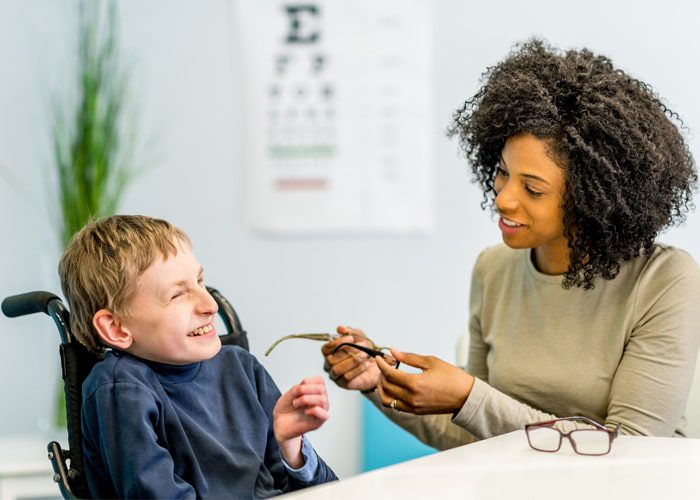For direct support professionals (DSPs) and others working in the intellectual and development disabilities field (IDD), acting as an ally for client self-advocacy is a huge part of the job. But knowing where to start can be tricky. Each client requires different things and has different comfort levels with speaking up.
To help your organization better serve your clients on their journey to independence, we’ve put together this list of best practices on being an ally for self-advocacy.
What is self-advocacy?

Self-advocacy is a way for someone with IDD to voice what they value the most, instead of what their family, friends, or support professionals value. When people serve as self-advocates, they are aware of their rights. They express what works for them and what they need individually. Self-advocacy is deeply personal.
Self-advocacy can help a person gain accessibility, support, and freedom. There are no limits to what self-advocates might choose to advocate for. Each time a person fights for their rights, needs, and goals, they are advocating for themselves.
The goals of self-advocacy
DSPs and other professionals in the IDD space need to understand the needs and desires of their clients in order to teach them to properly self-advocate. While what each client will choose to advocate for is different, the following goals can help lay the groundwork for their self-advocacy:
- Human rights: These are safety, dignity, respect, privacy, and more. This also includes freedom from abuse, access to healthcare, and inclusion in the community.
- Self-direction: This is a person’s right to choose and do what is important to them. Self-direction includes everything from a person choosing their own clothes to choosing where they live.
- Access: This means being able to use places and services that people without disabilities can use. Examples of access include ramps into buildings, closed captioning on televisions, and doors and hallways wide enough for a wheelchair to pass through.
- Accommodations: These are changes that offset a person’s disability, usually at school or work. For example, a person who cannot see may need a screen reader to do work on a computer.
How to serve as a support and ally for self-advocacy

The ability to support individuals’ independence should always be top of mind for any provider. The following are some ways to make sure individuals can self-advocate.
1. Talk to the people served about the situation
Regardless of the individual’s communication abilities, it is important to discuss their needs and desires. Assuming they aren’t concerned about or won’t understand the challenges they face can increase stress and anxiety.
Share in their emotions, find ways of coping with the changes, and determine how much of their daily life is affected by social or systemic barriers. Increasing their knowledge of their situation makes them better able to advocate for themselves.
2. Listen to what clients tell you
To support self-advocacy, you must listen. Listening means both hearing what they say and making sure they have a chance to say it.
You must actively seek someone’s input, then give them the time and support they need to communicate. Listening includes all types of communication, including nonverbal communication.
3. Adjust goals and services as needed
Providers must be flexible in their approach so that individuals can maintain as much independence as possible. This also helps to ensure that any progress made toward goals is not stalled.
Consider this example: An individual has a goal to increase social interaction, and one way they accomplish this is by visiting their friend on the weekends. If there’s a week where physically visiting their friend is not possible, the organization can help provide access to a web conferencing platform and the individual’s support team can teach them how to navigate it.
4. Provide support to families and other caregivers at home
For individuals who live with family members, it is important for providers to help support these families by providing resources for proper continuity of care.
A large part of helping clients learn self-advocacy is helping them learn their own self-worth. While providers can do a lot in this regard, what clients hear at home has an even larger impact. To that end, work with your clients’ families to make sure they understand how to promote self-worth at home.
5. Know when to pull back and limit your input
People with disabilities are often over-protected. Other people want to shelter them from failure, pain, or disappointment. Although they usually have good intentions, this isn’t always fair or in the person’s long-term best interests.
When a person makes a choice, they are responsible for the outcomes. Your responsibility is to embrace the person’s right to make decisions with unknown outcomes and continue to support them.
Respecting a decision is not the same as simply letting someone get hurt. You have a responsibility to provide the support a person needs. This can include pointing out risks and concerns. However, you also have a responsibility to recognize when they understand a risk and choose to accept it.
While it can be difficult to respect a decision you don’t agree with, it is a critical part of supporting self-advocacy.
A Day in the Life: An IDD Perspective
People with IDD face many challenges in their daily lives. Sometimes, these challenges are due simply to how other people treat them.
The goal of this course is to give DSPs in IDD settings some perspective on living with IDD. In this course preview, you will see through the eyes of Jessica, a fictional person with IDD. The experiences you will see are common for people with IDD.
Preview the course →





